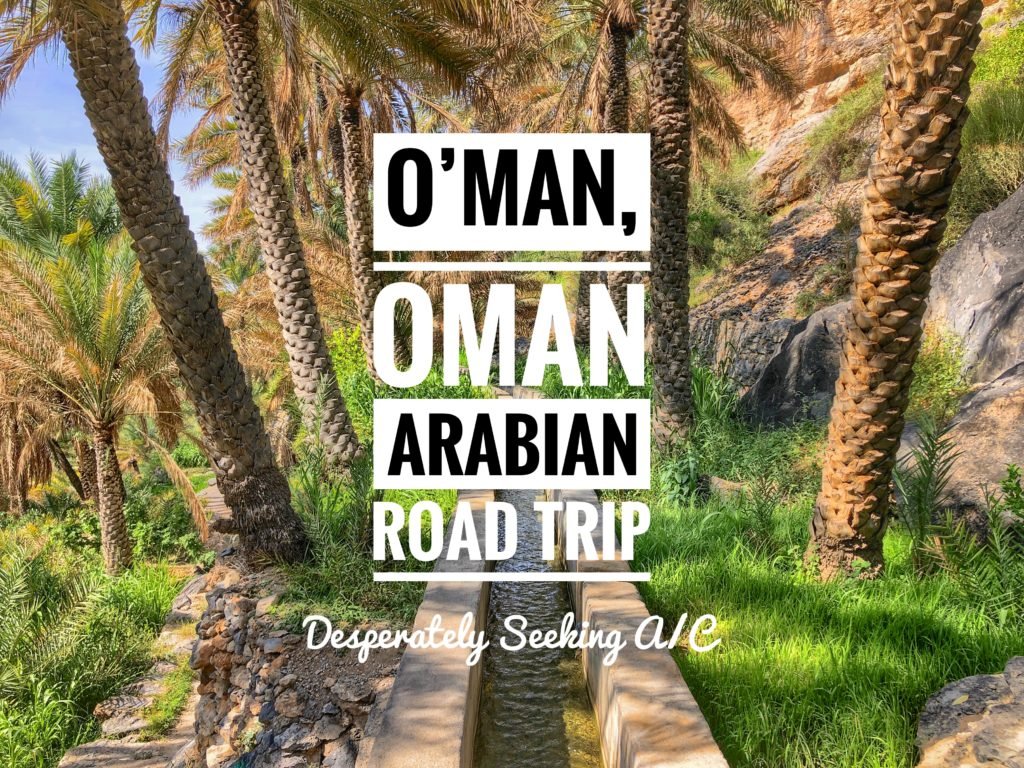
A four-night wild camping and road trip in Oman seemed like a worthwhile idea in theory when we planned it. Lots of backpackers and locals do it, it’s totally free (minus the $20 cheapie tent we purchased), and would allow us to get in touch with the beautiful nature, off-the-beaten-path villages and real culture of the country. And we knew it would be hot…but not this hot. Not at night. Not so completely oppressive that you feel like a red pepper roasting over an open flame wilting as all the moisture gets sucked out of you, no matter the time of day. Needless to say, our one night of camping led us desperately seeking the sanctuary of A/C in the nearest guesthouse for night two (and three…and four). Glad we did it because it made us admire even more the strength and endurance of the people who live and work on the Arabian peninsula and have for thousands of years. We are in awe.

It started with an easy car rental with a reputable company we found in Muscat called Nab Car Rental. For five days it cost 65 Rials or $168. They were fantastic…trouble-free, not pushy and incredibly customer service oriented. Driving in Oman was also really easy. There was very little traffic outside of Muscat, although you do need to watch your speed because there are cameras that cover the country and track speeds, issuing immediate speeding tickets. The only challenge was that Nab, like all car rental companies in Oman, only include 200k a day (124 miles) which is practically nothing so we didn’t get to go as far as we would have liked. The good thing is that because we were in the Middle East, filling up was cheap at about $15/tank.
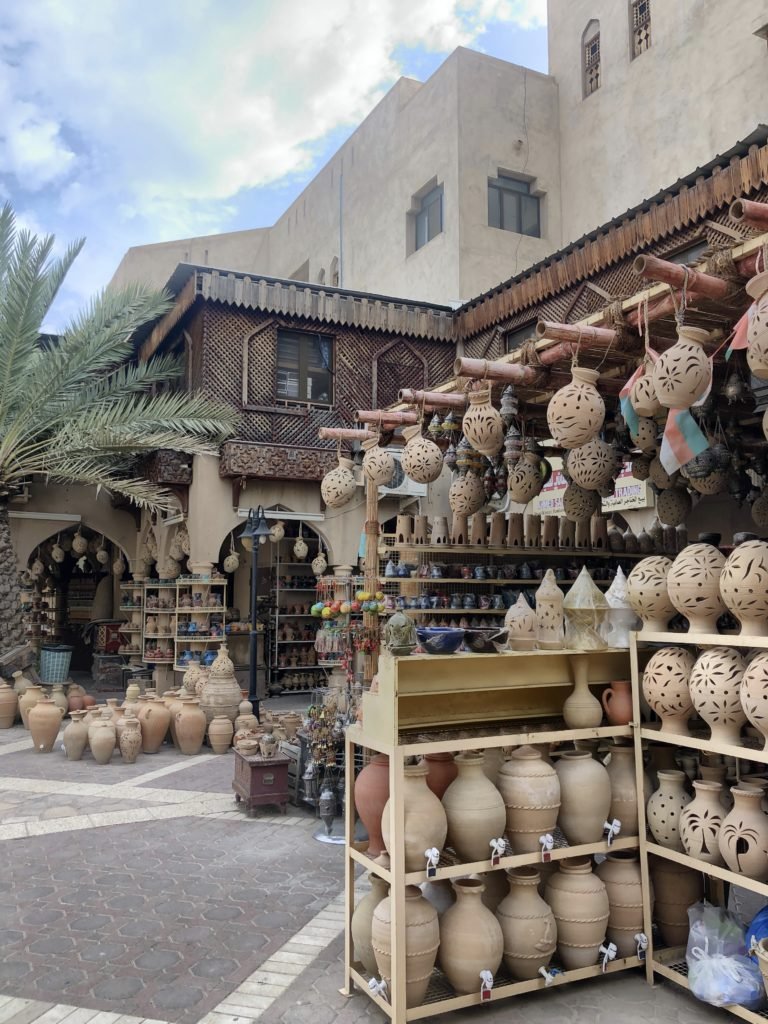
Prior to camping, we spent the day exploring around the town of Nizwa on the interior of Oman where we checked out the expertly made clay goods in the historic town of Nizwa. The town lies on a rocky desert plain encircled by a centuries old blanket of date palm trees, and is sometimes known as the “Pearl of Islam.”
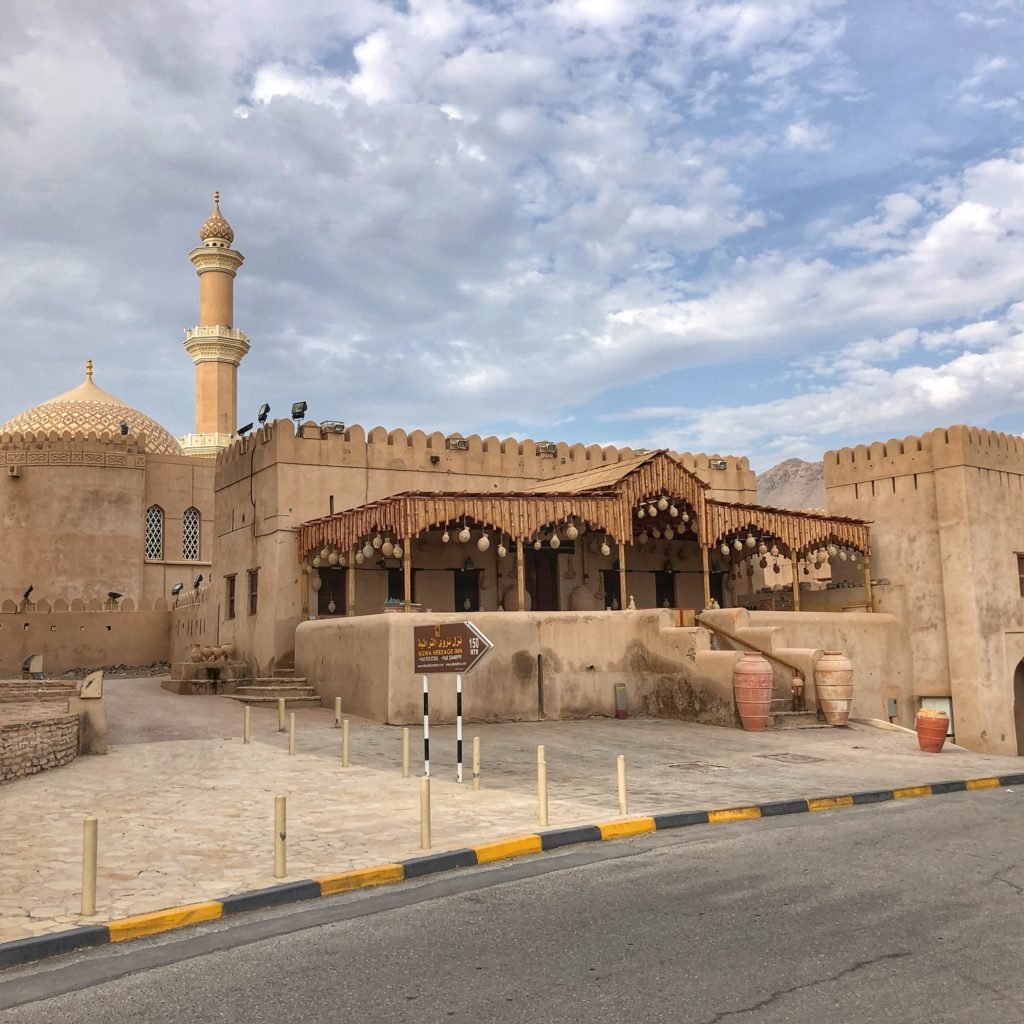
The mosque hides amongst the old fortress walls and souq in Nizwa.
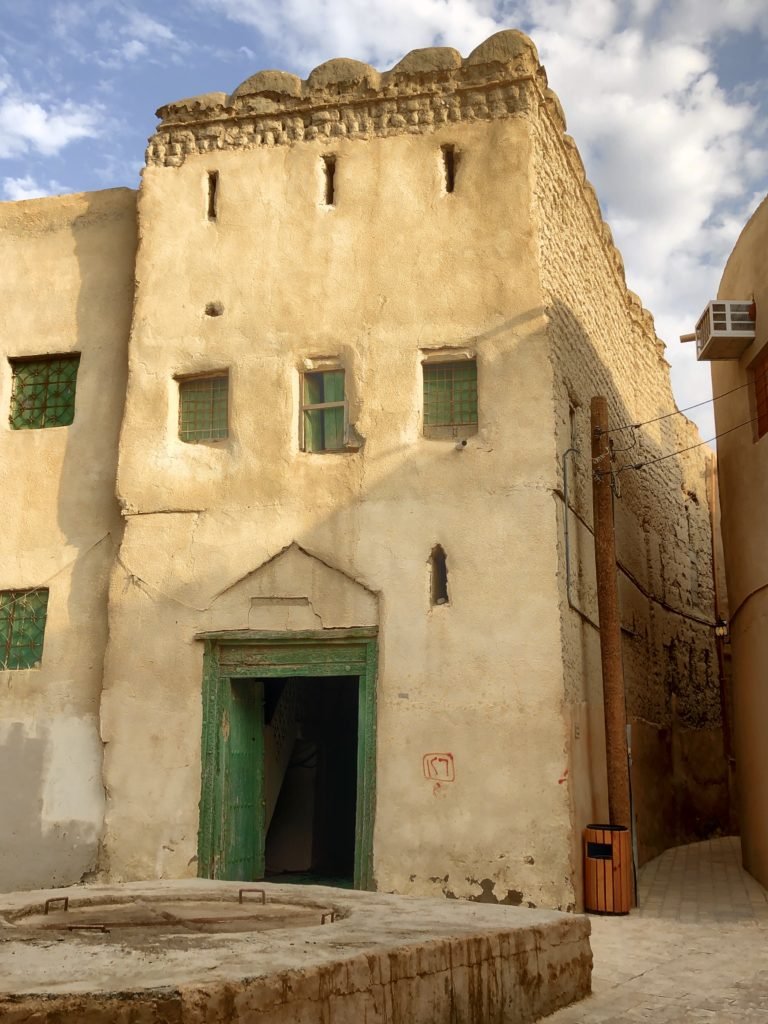
Part of the mud village that still exists in Nizwa.
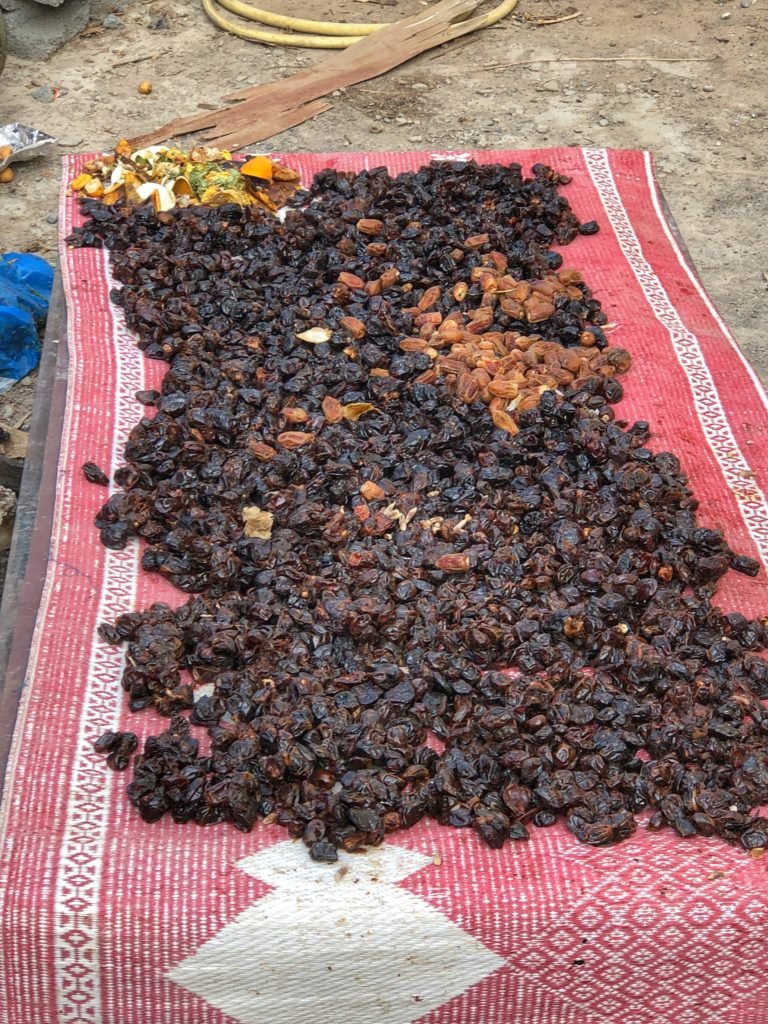
We were lucky to be in Oman during date harvest season so let’s just say, “keeping regular” was not a problem with these fiber rich treats during our stay. In fact, we’ve never sampled so many different types of dates! Some were mushy (the freshest ones that aren’t yet dried), some chewy, (the dried ones), some floral, some sweet, some rich, some molasses-like, some musky, some decadent….We were astounded to discover that there are 200 different types of dates in Oman! Here in Nizwa, we saw them drying in the sun. In other regions, we saw men climbing up date palms to collect them, carrying them on their heads in massive baskets to be dried in the September sun, and of course we got multiple hand-outs from locals.
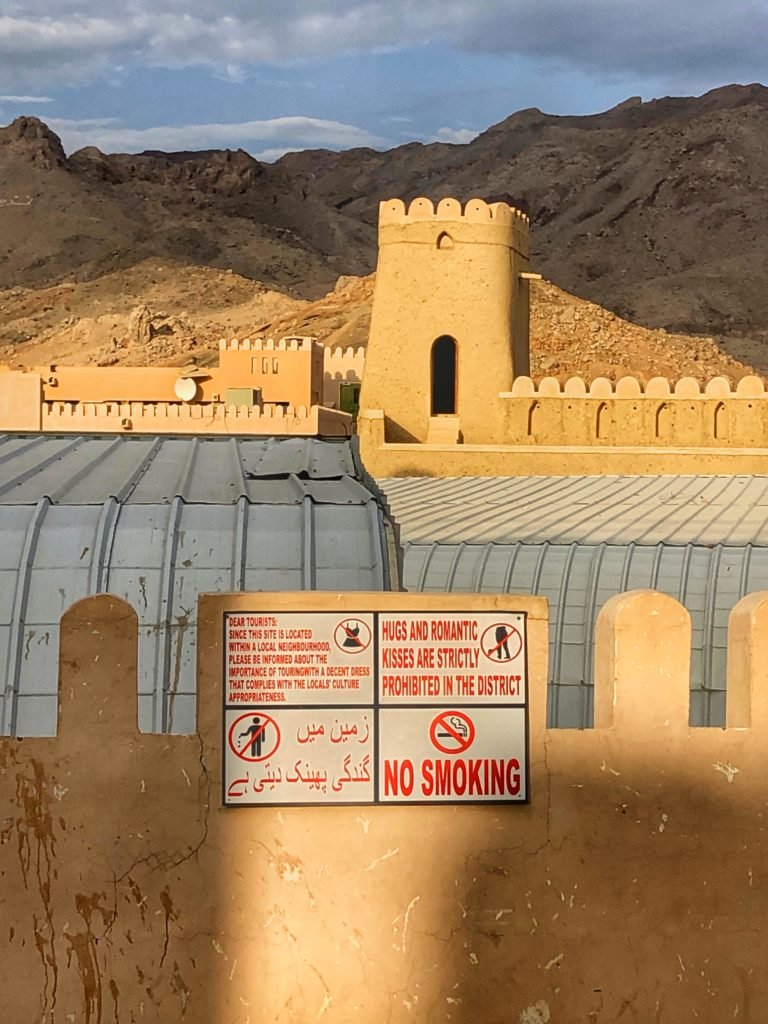
Nizwa, like many places in Oman, is still a very conservative town… there are nice little nudging signs like these all over to remind the visitor that good non-offensive behavior and respecting local traditions is appreciated.

Enjoying the remarkable ruins of the traditional mud, brick, and straw structures of the traditional Omani villages in the interior, we stopped at the old Tanuf Castle and town ruins where we caught a sensational desert sunset. Ruins like these in Oman, we’ve learned, are precious glimpses into how raw and simple desert life used to be. This traditional village was lived in until the 1950’s when it was bombed out by the British; largely destroyed during the War of Al Jabal.
This was the first mud brick village we went to, little did we know how jaw-dropping these special places would be the next day.
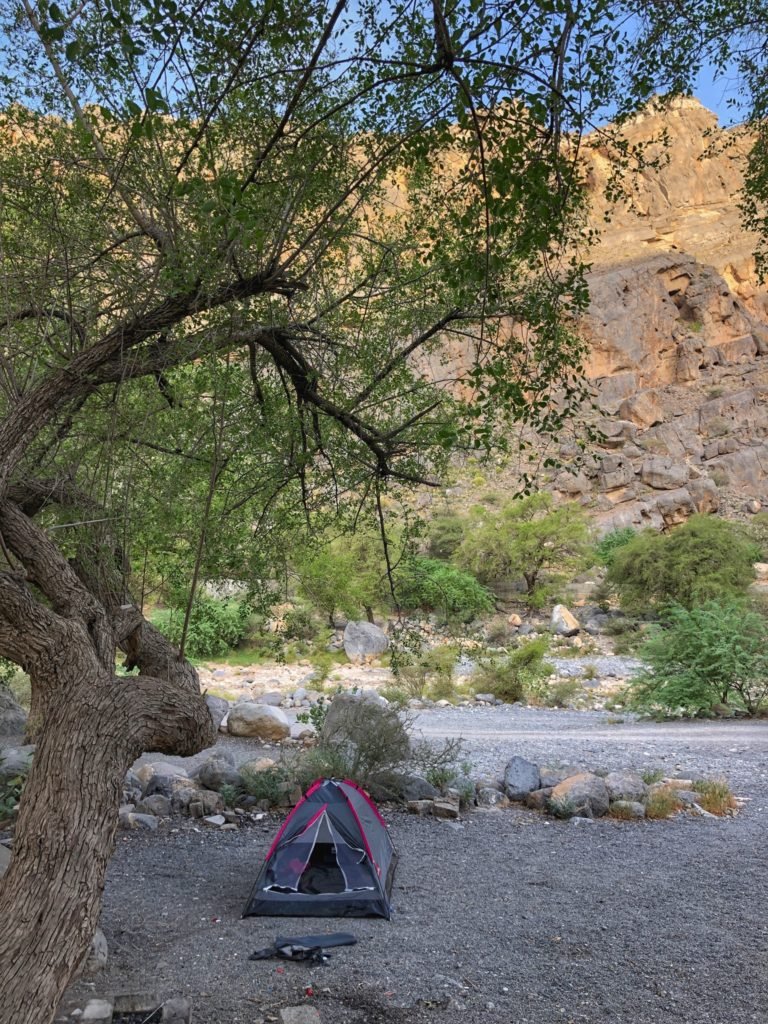
Arriving to our campsite for the night, the setting was gorgeous. The weather…not so much. It was still about 38 degrees (100 Fahrenheit) at sunset. Naturally, based on good life knowledge, we thought surely it will cool off soon, right? It did. For about 15 minutes at dusk. Then, the temperature seemingly shot back up and we found no relief from any wind, it was utterly still. We had already set up camp and Greg had crawled into the tent to read (at 7:30 pm because this means nighttime here), while Mandy set up a pillow pallet (we literally bought vacuum-sealed pillows for our sleeping mats at the hypermarket) outside the tent and prepared to sleep outside under the stars for a chance at “fresh air.”
Our nightclothes were already completely soaked through with sweat when Greg emerged from his hot pocket to take a wee about 30 minutes later. Only steps from the tent towards the bush he encountered a very very large snake, that any sane person would jump back from in horror…Black, Girthy, and Slithery. Needless to say, we packed up and spent the rest of the night in the car, tormenting ourselves with the stagnant, and windless evening air and baking in the car. Oh, let’s not forget the mosquitos. WTF? Aren’t we in the freaking desert?!
Here ends our camping in Oman adventure.

The next day, after some incredible sightseeing, we ended at the first guesthouse we could find, where we found the most interesting “east meets west” toilet experience. Oh yes, we had A/C now…but the adventure continued. ?

Moving on, we encountered more of this unbelievably rugged and harsh desert landscape. The pictured tower is one of many ancient fortified mud brick, or sandstone watchtowers scattered across the land to remind you of the much more turbulent past that was once here. They acted as sentinels to guard caravan or trade routes throughout the region and along the coast.
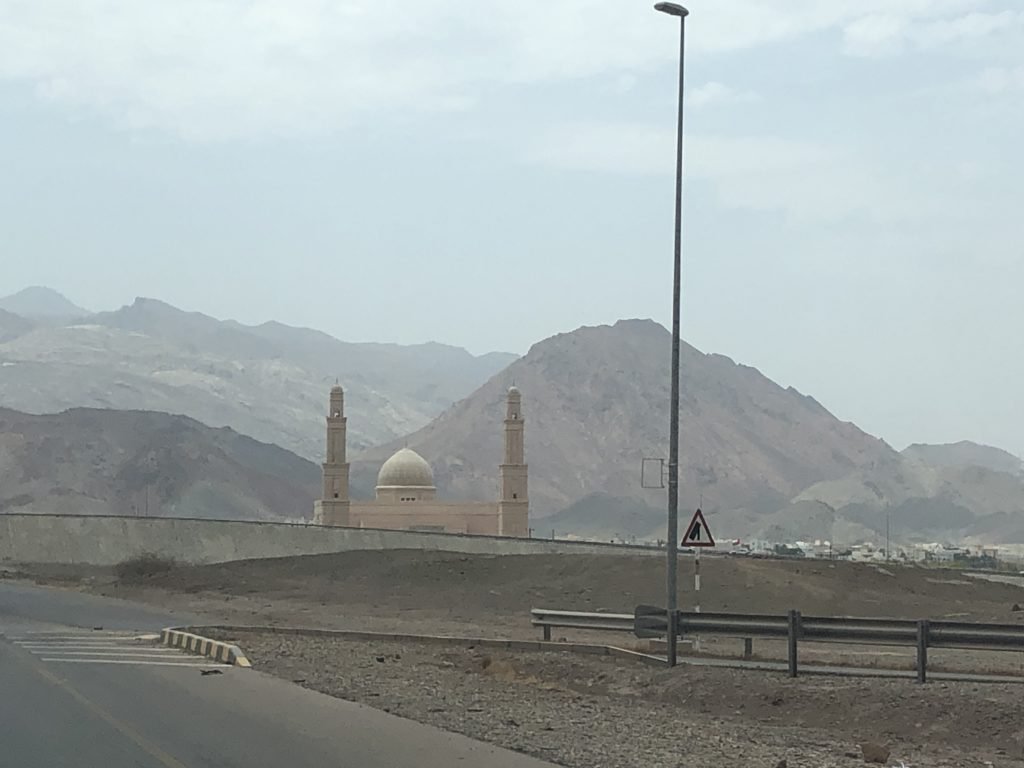
The starkness and aridity of the land we drove through. It’s truly hard to imagine how people carved their lives out of such a harsh and punishing landscape.
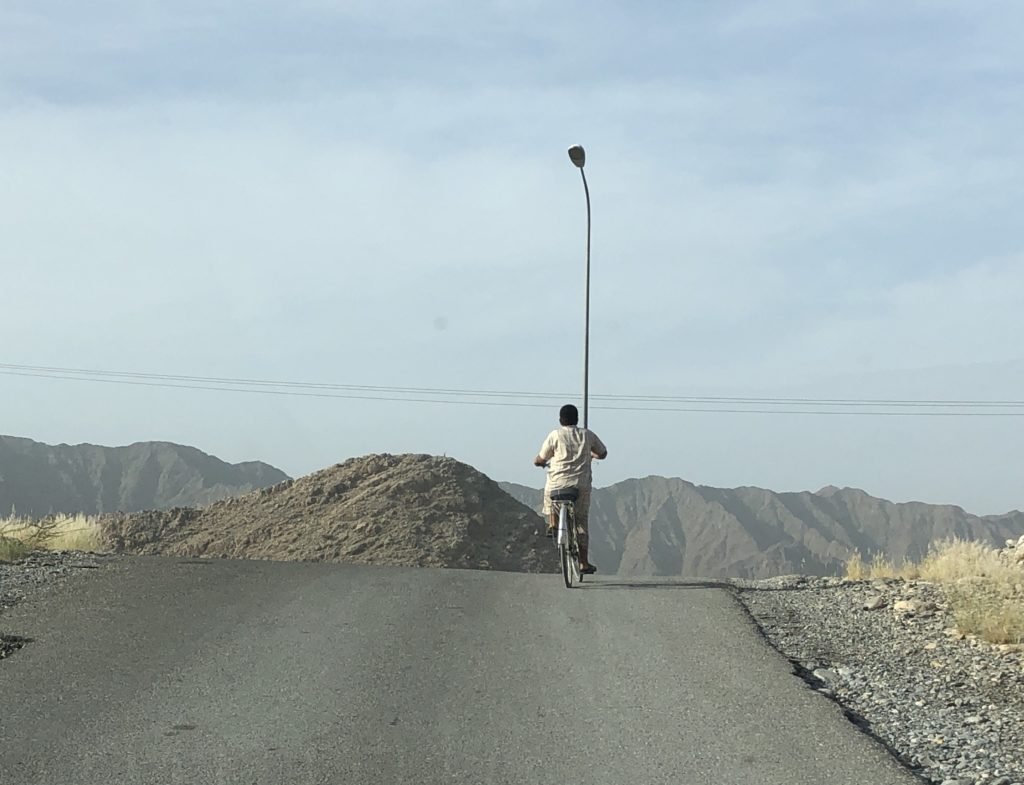
An Omani school bus. Naturally boys and girls are separated into different schools and buses.
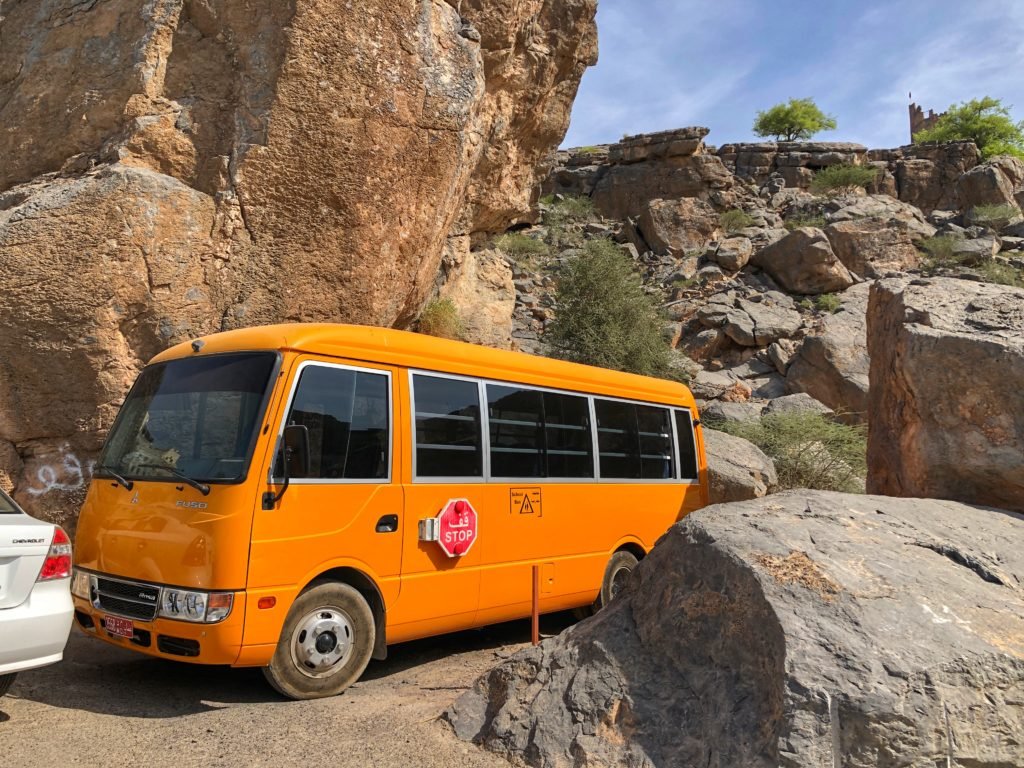
A young boy rides a rickety bicycle uphill in a floor length dishdasha (gown) in brutal heat. Again these people amaze.

At 1000 meters, the village of Misfat Al Abriyen in Oman is a miraculously lush mountain oasis surrounded by a parched and forbidding barren land. The village pops from the landscape thanks to its ingenious agricultural terraces, no doubt built up over centuries of labor and patience where bananas, papayas, citrus trees, and of course date palm trees are grown. Here you can see the newer section of Misfat town, which sprouts up from the verdant carpet of date palms.

It’s all thanks to the remarkable network of man made canals, or falaj, which have been delivering the precious life giving and sustaining water from ancient mountain springs to the village and farmlands since at least 500 AD. The systems of falaj are fittingly inscribed into the UNESCO recognized heritage list.
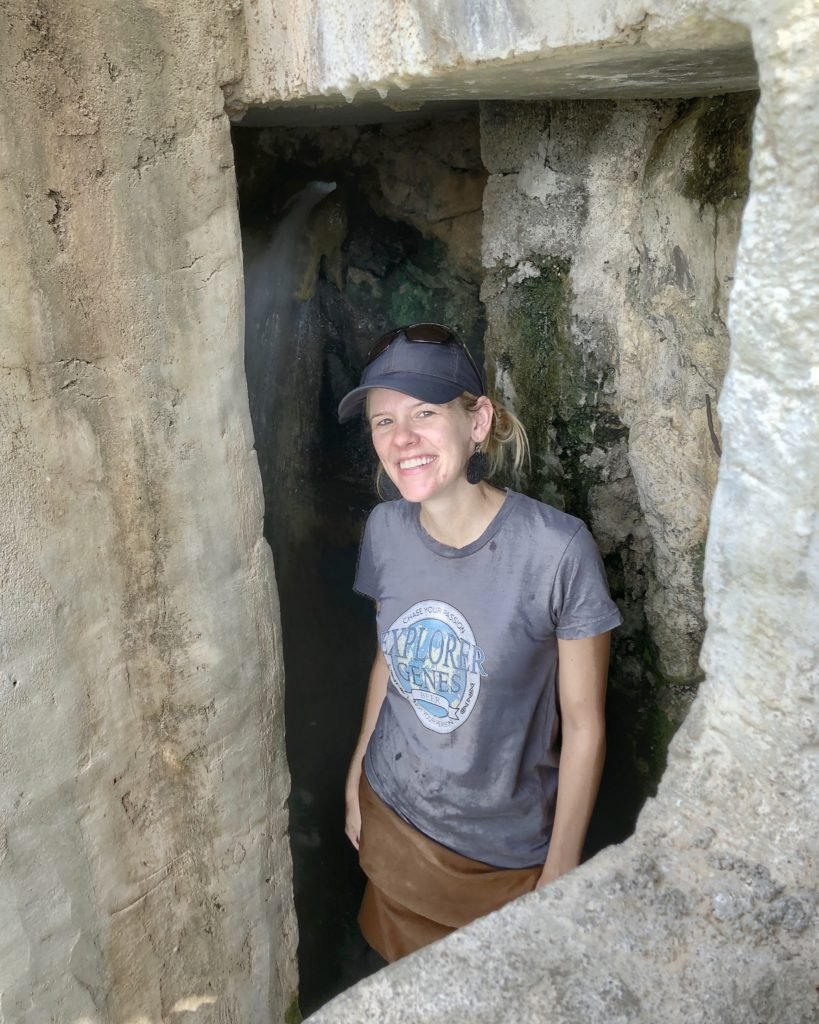
Within the falaj system is even a built in shower where the water bursts into a secluded little pocket.

The trail around Misfat is also marked well. We would have walked the length of it, but were already boiling.
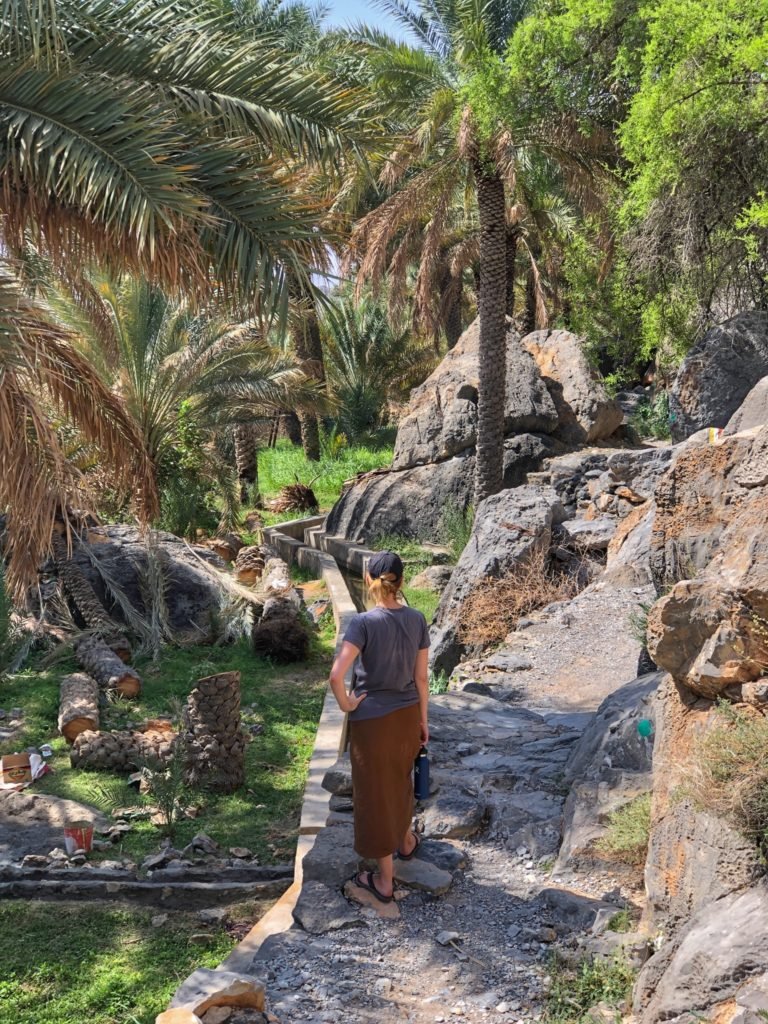
Mandy pauses to take in this stunning oasis.
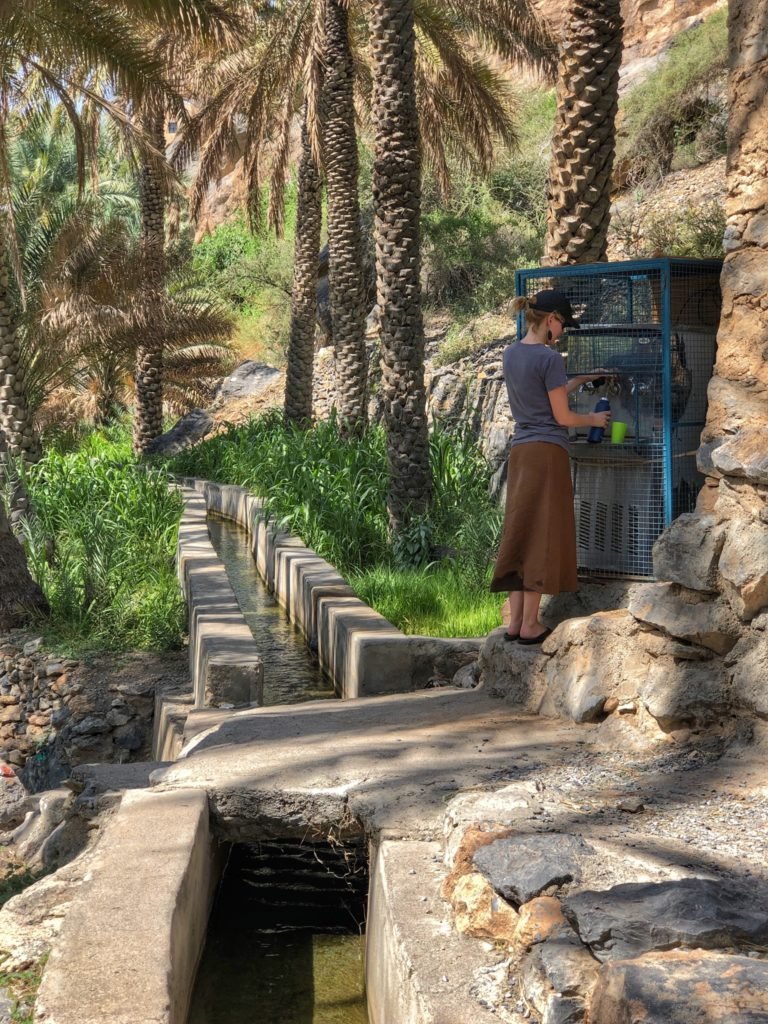
Throughout Oman, you will find another blessed source of water… public refrigerated water stations to freely refill your bottles. We’re easily drinking 5-6 liters of water a day between us so having this as a readily available resource is a true godsend. It doesn’t take you long to realize just how precious a commodity is here in this agonizing heat.

Natural, old houses in Misfat al Abriyeen are traditional mud brick and stone houses with palm frond roofs and palm wood beams for floors/ceilings and doorways. They are unique in that they are built on solid rock foundations, likely as a means of providing security during the olden times. (Omantripper.com) The houses are remarkably constructed using mud and clay to meld everything together, and finished with an adobe-like coat of plaster. All together the houses look uniformly constructed, as if they are one building, of one village. We’ve never seen anything like it! Extraordinarily unique craftsmanship, from a different era.

A couple of locals haul ass back to their hotel. This is one of only two inns in the village.

There are several lovely marked paths and hikes you can take to weave through the terraced gardens and on up into the mountains. Mandy walks along the edge of one of the falaj canals clinging to the cliff here. Notice the dates wrapped in nets on the tree nearby. These are to protect the dates from insects. Better than pesticides…
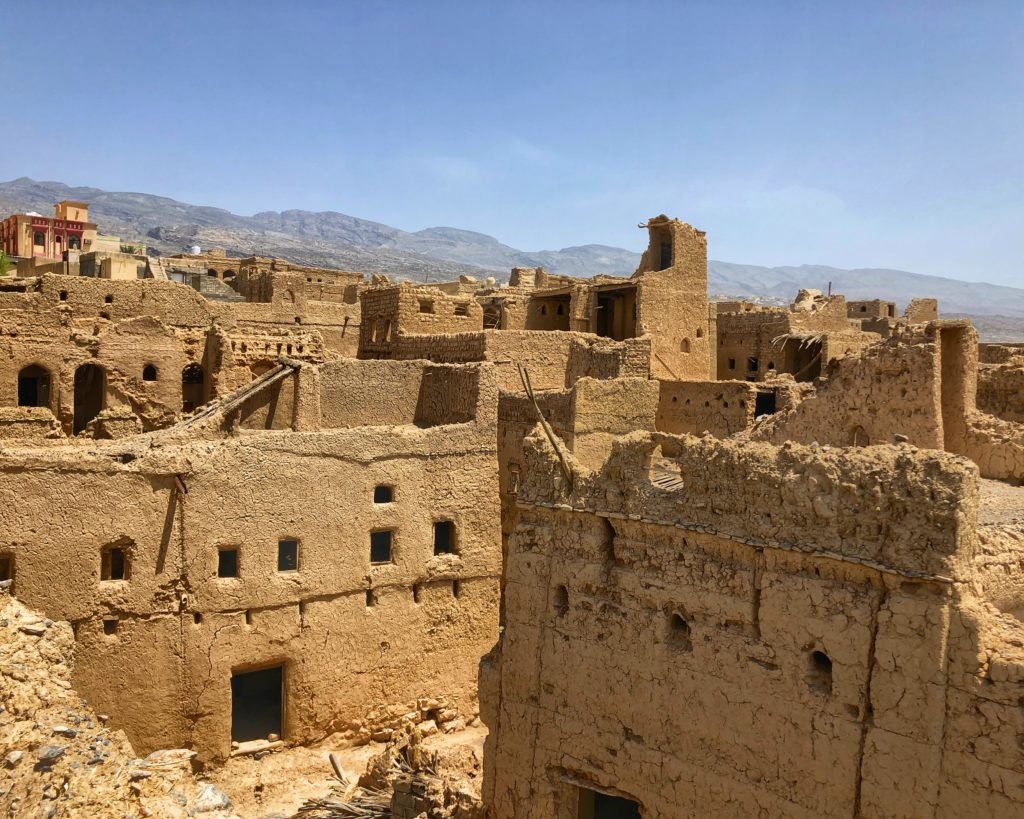
The next day we ventured to al Hamra. Al Hamra, has one of the best-preserved old towns in Oman. It’s easy to feel eerily transported back hundreds of years as you wander among the abandoned traditional mud houses all terraced into the hillside, winding through the stone-strewn alleyways, and along a tranquil falaj water system, that also doubles as a local lazy river to swim and bathe in.
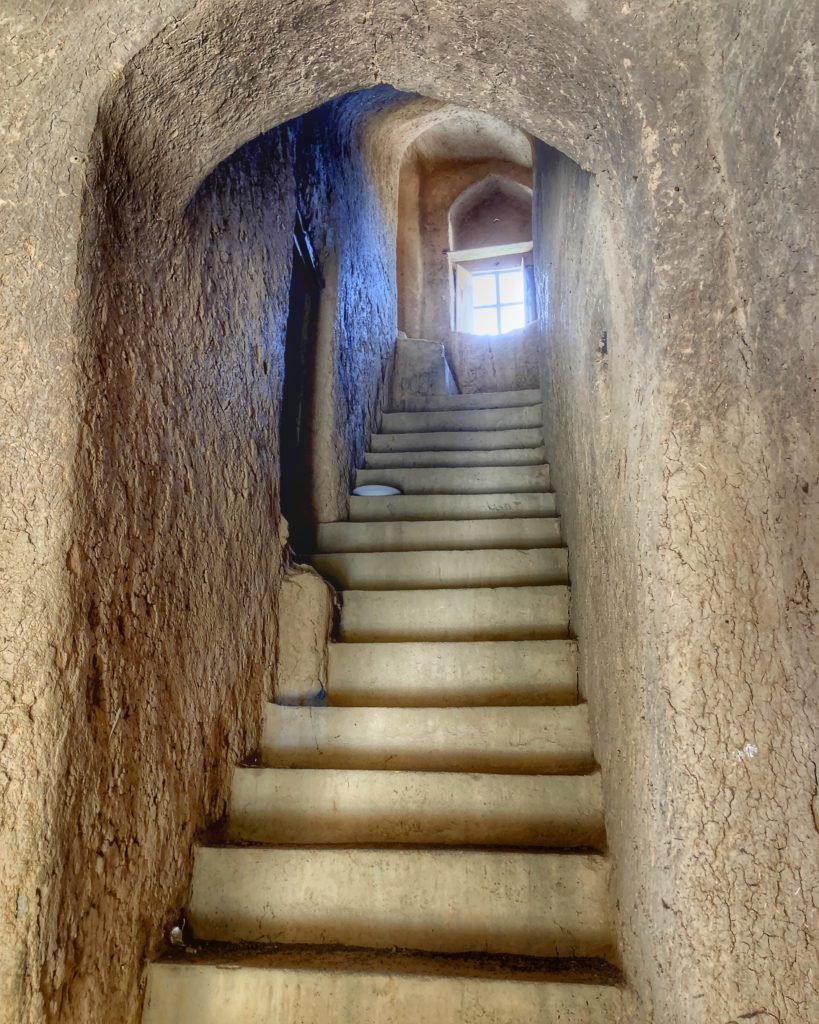
The most interesting thing about Al Hamra was being able to wander inside the ghostly mud structures (some 4 stories high!) and feel like we’re seeing and feeling 400 years of history, peeking into an exotic and totally new world. Free to roam…we explored one house, venturing up the stairs.
It was as if we were entering a long forgotten time capsule of a life in a cherished home, left as a reminder of what once was all someone had. We could imagine the generations it must have taken to fight to build this place, and all the strife that it took to make it a home. Personal belongings like shoes, books, clothing and dishes lay strewn about…we wondered about the people who once held these things in their hands.
Incredibly intricate construction, and craftsmanship of these houses. Just Stunning!
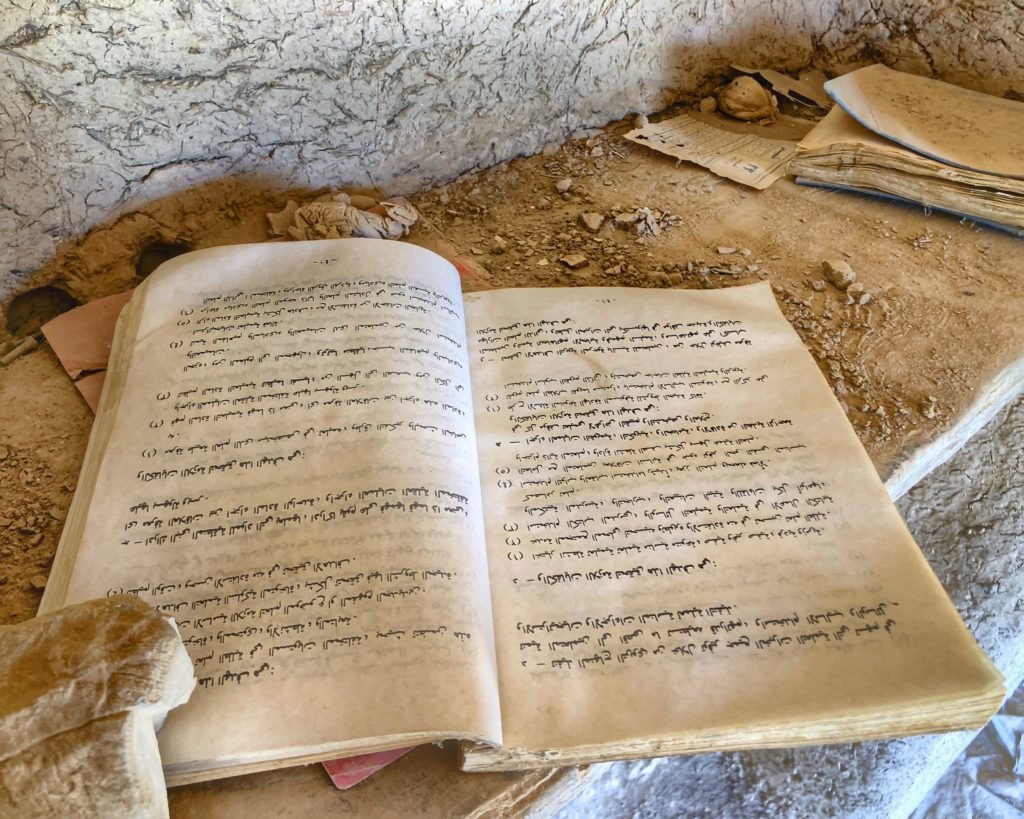
A book left behind. Wish we could read it…

It’s hard to comprehend the complexity, knowledge, technique, and time that was used to combine mud and clay with stone, wood and straw to make this entire village. There were hundreds of homes!
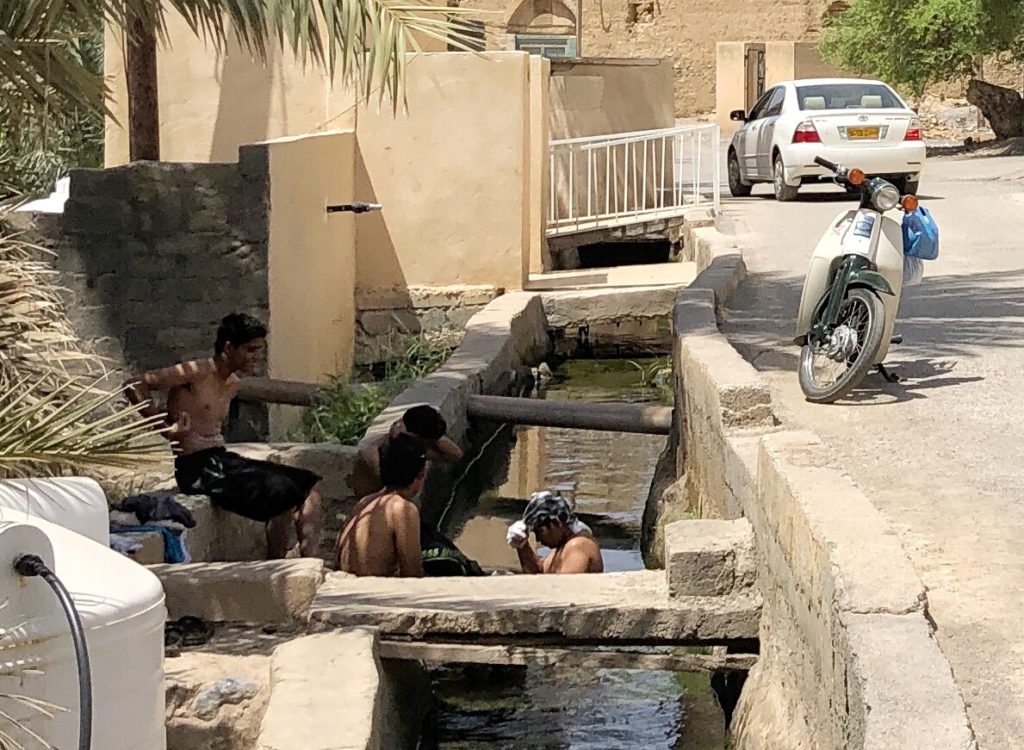
Locals bathing in the falaj, complete with soap and shampoo. A peculiar thing about these falajes is they contain many small fish which function as beautifiers are to chow down on dead skin cells from your body (similar to a fish pedicure in Thailand but with unlimited whole body access.) As we were strolling by, we received a few smiles and greetings from the men and children, but all in all, a lot of curious stares and gazes.
However, later we encountered a perplexing incident when a car-load of women and kids stopped at us, jumped out and bee-lined to Mandy, completely bypassing Greg. They asked politely if they could “take photo?” Sure, we said. One of the women thrust her baby into Mandy’s arms and said “photo, photo!!” Then the other woman deposited yet another baby into Mandy’s other arm. Mandy, more surprised than anything, smiled sheepishly and in amazement while the Omani women snapped photos of her…she was suddenly something unique as the intriguing white woman with blonde hair. The experience was quite a rush. We only wish we’d had our camera ready as well.

The UNESCO world heritage site of Bahla Fort, mud-walled oasis in the Omani desert, which owes its prosperity to the Banu Nebhan tribe who dominated the central Omani region and made Bahla their capital from the 12th to the end of the 15th century.
Into the Wadis
If you are going to Oman, hiking/swimming through the emerald Wadi Shab is one adventure that must absolutely be on your list. It starts with a quick boat ride across the Wadi (canyon), you walk about 30 minutes which is long enough to be oozing sweat from every pore, and then are blissfully greeted with the first alluring pool to walk through. After about an hour altogether, you stumble upon a swim through cave, and the grand finale waterfall, which you can climb up using the provided rope and jump from. Easy to do independently…the trail is marked with black arrows, so no need for a guide! Plan to get completely submerged and shoes you can swim with.
You will wade alongside palm groves and rugged cliffs on either side of you.

Cannot even begin to say how refreshing this water was after enduring the oppressive furnace.
Swimming through the cave at the end. You do have to be a decently strong swimmer because the final section is about 100 meters of straight swimming before you reach the cave. The cave itself does have convenient ridges along the sides of the rock for handholds, but definitely not for the claustrophobic as there are sections that are barely big enough for your head!
When the cave widens, right before the waterfall appears (the third picture.) Seeing that waterfall for the first time is truly an experience. Just jaw-droppingly magnificent.
Although the trail was completely empty except for one Australian guy and his guide on the way down, on the return, we got to meet a great group of Nepalese expats who lived in Muscat, as well as a Colombian/Dutch guy traveling together. The Colombian seemed surprised (and pleased) to hear that Colombia still ranks as our favorite country we’ve ever visited.

Another notable watery attraction is the Bimmah Sinkhole which is on the same road as Wadi Shab about 600 m away from the sea. The sinkhole was formed by a collapse of the surface layer due to dissolution of the underlying limestone. However, the locals believe that it was created by a falling star. There is no fee and you can swim in the cool, clean waters and even have little fishies chow down on your skin like at a foot pedicure spa. It’s utterly amazing!!
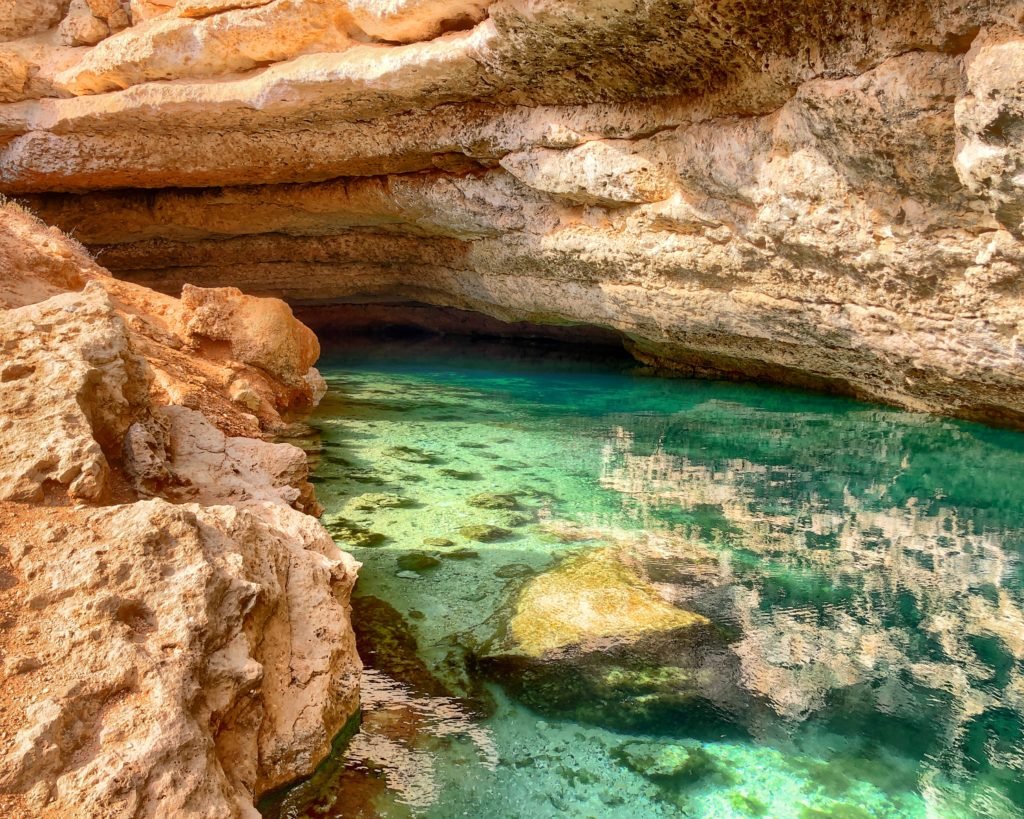
From surface level, it’s a whole different perspective. It reminded us a lot of the cenotes on the Yucatán peninsula.

Catching glimpses of the Arabian Sea and touching the Indian Ocean for the very first time.
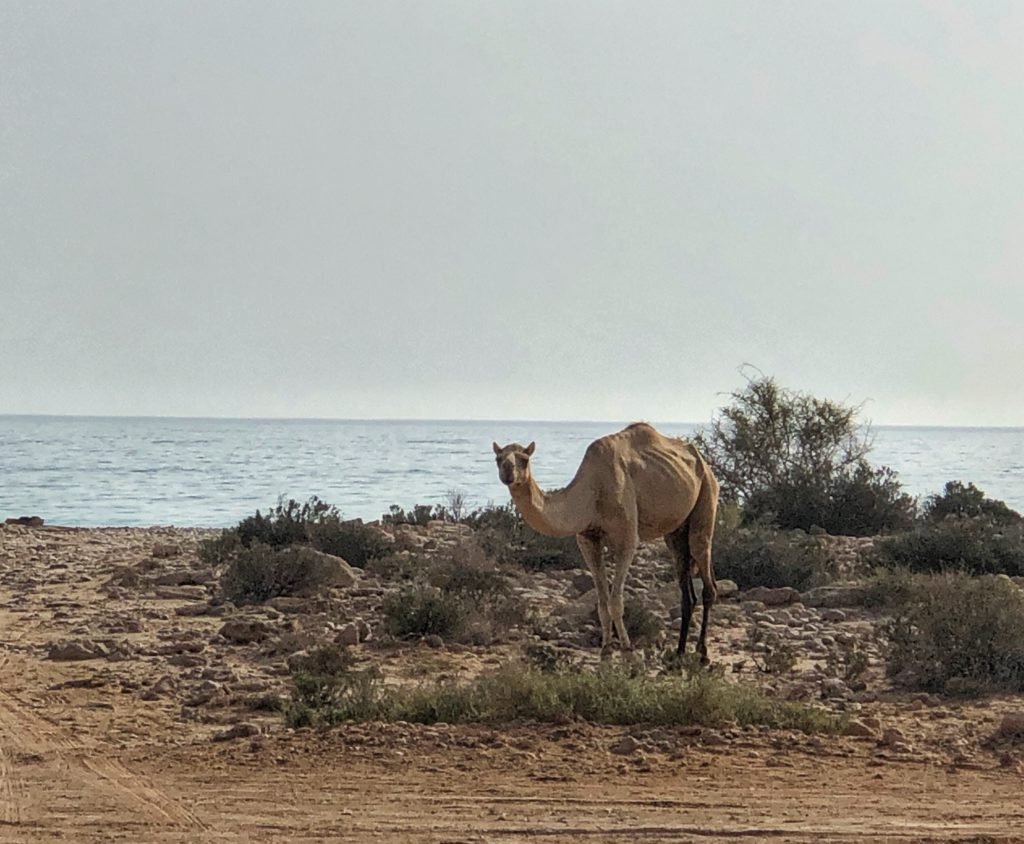
Now it feels like Arabia!
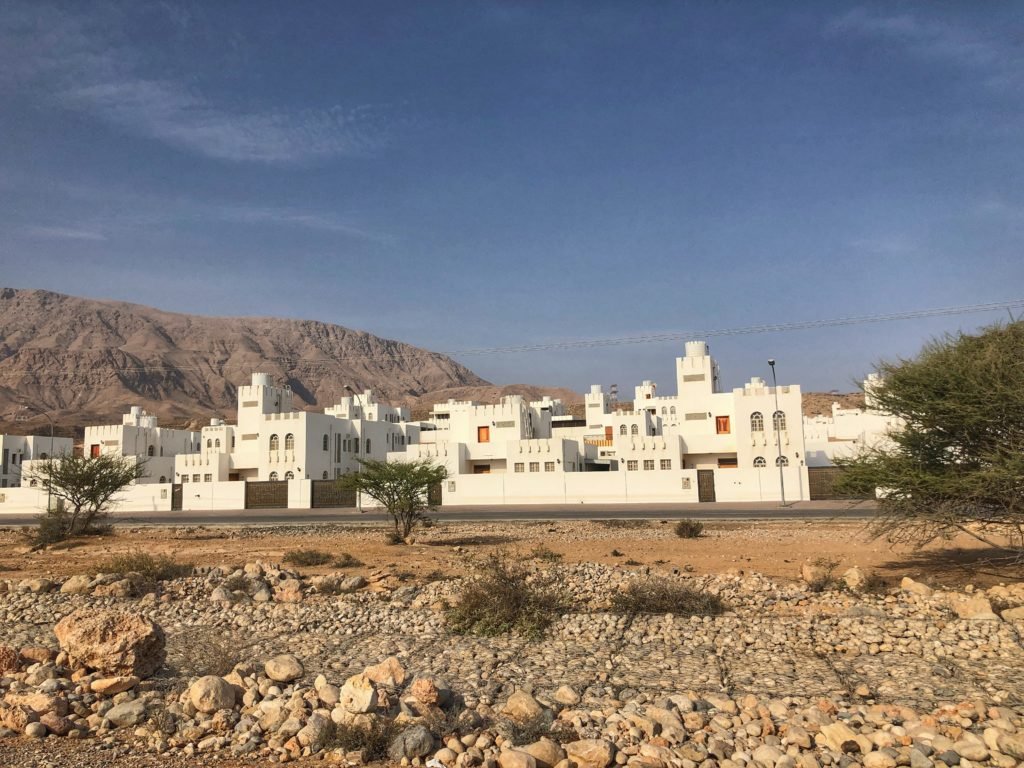
Passing one of the many authentic villages that dot the coast. It’s a bylaw in Oman that all dwellings must be painted shades of white in keeping with traditional Omani colors.
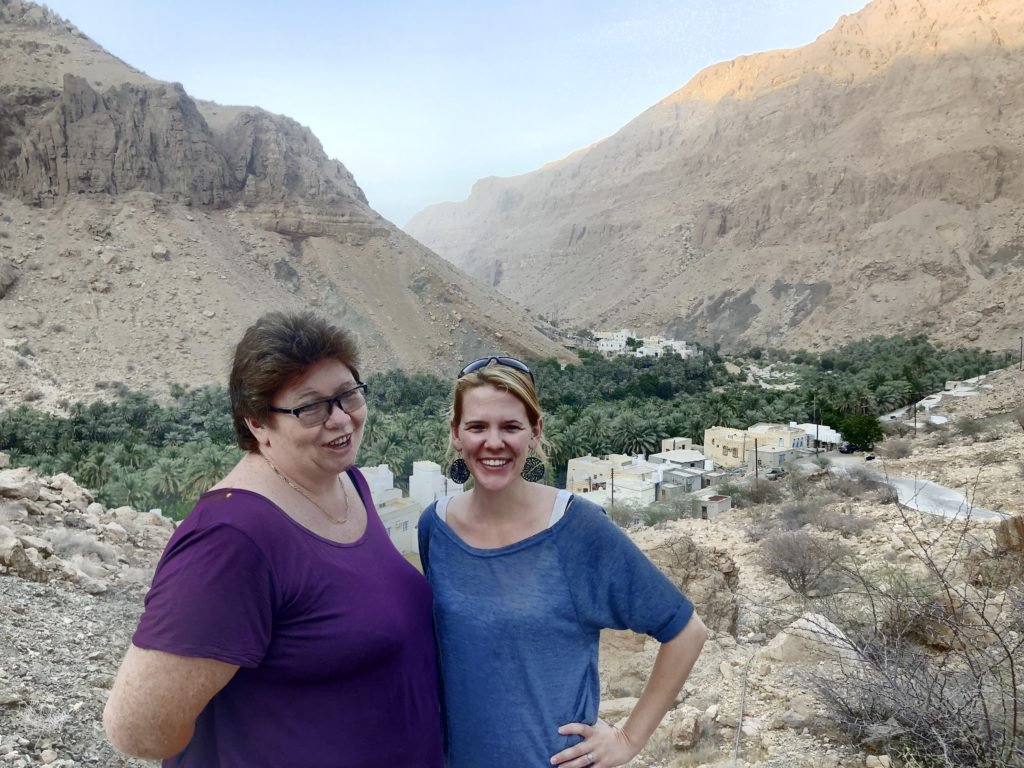
On the final two nights, we stayed at an AirBnB hosted by a wonderfully welcoming British expat and eccentric English teacher named Debby. She had been teaching in Oman for over a year and turned out to be an absolute whirlwind of information and insights…truly a barrel of laughs and a joy to get to know. Debby’s place was utterly comfortable and was strongly air conditioned just a few steps from the sea.
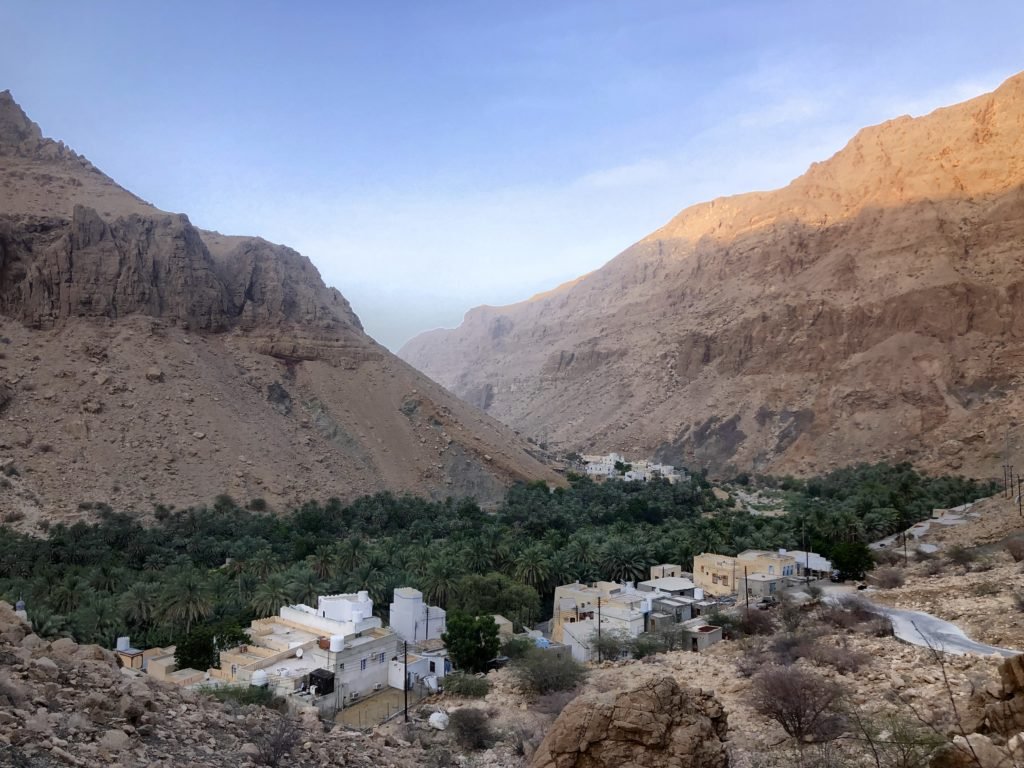
Debby very kindly took us for a spin in her 4×4 up the mountain to a small village that was the most authentic and seemingly untouched place we had seen in Oman. As we got out of the car for a stroll, all eyes were on us, it was as if they had never seen white people before. We quickly became surrounded by little girls in vivid handmade dresses while their mothers sat timidly on the stairs regarding us with cautious interest. Unfortunately, it’s unacceptable to take pictures of women, and girls in this part of the world so our phone remained reluctantly in Greg’s pocket so we can’t share this place and people with images.
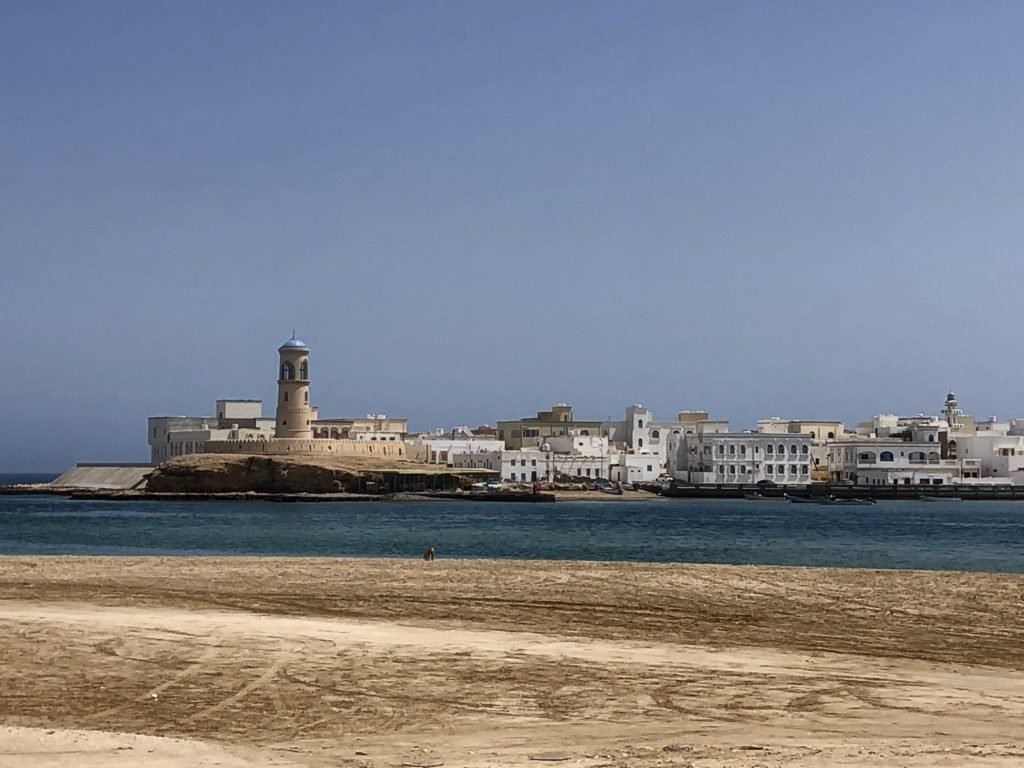
Checking out our most southern on our trip, the town of Sur was a lovely seaside town with a long history of being a port and of dhow building.
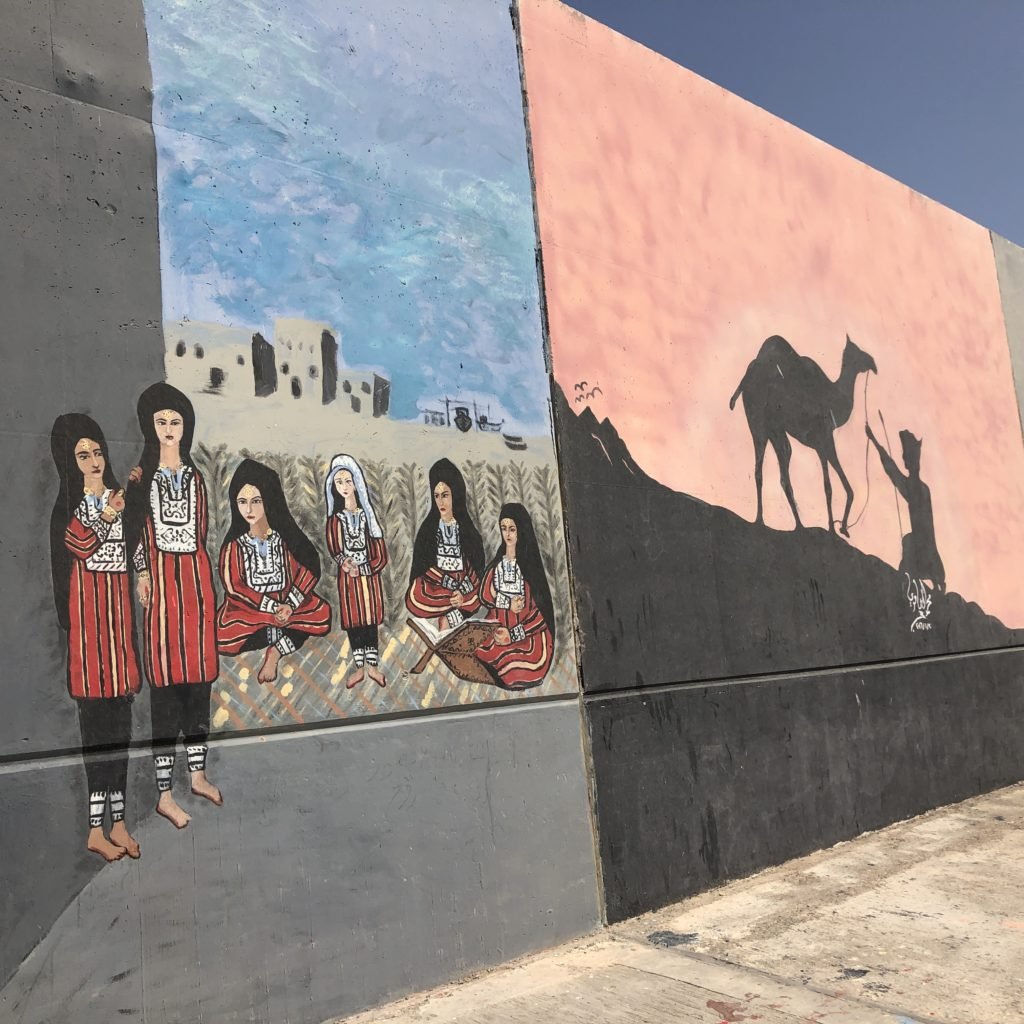
Sur’s seaside pier curled its tongue far into the harbor. Painted on it was a collection of local artwork, which complemented our walk along it as we gazed into the nearby sea and were amazed at the bounty of sea life present in just a few feet of water…schools of fish big and small, including parrotfish, cuttlefish, angel fish, and lots of plastic. No matter where we go, we’re so tired of seeing our planets’ natural areas being littered and polluted by plastic…
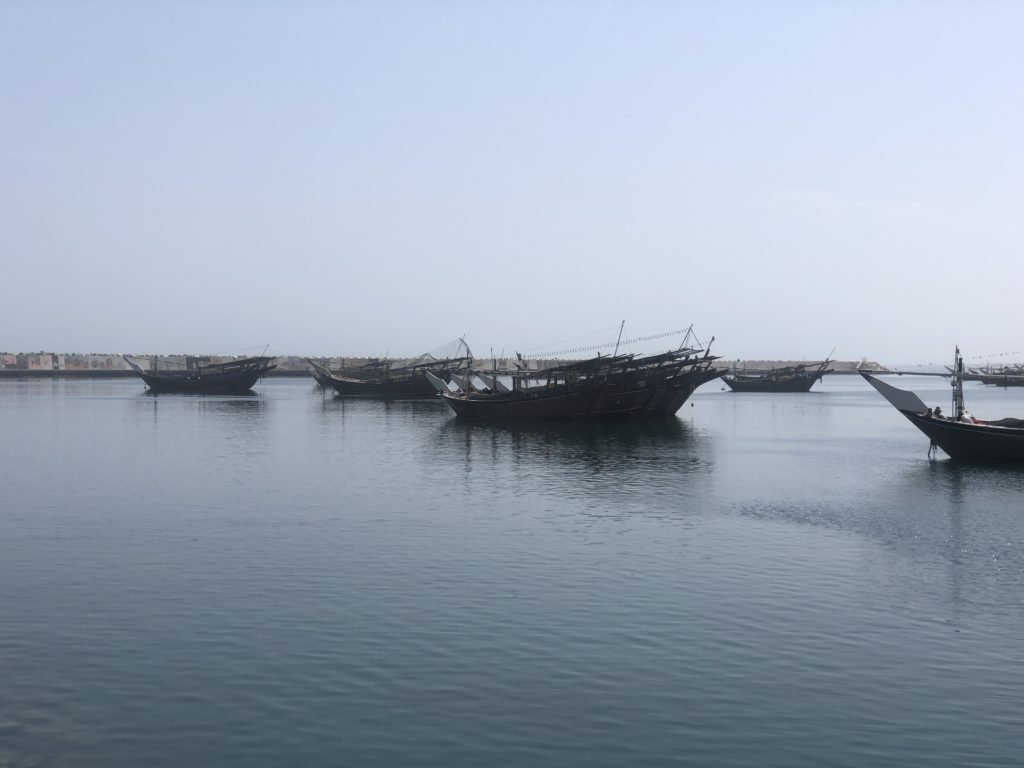
Dhows anchored on the water near the pier.

Visiting the Sur Fort.
A sudden and surprising glimpse of our first phosphorescence in the sea and beaches in Oman! This came across this unexpected and magical light show walking in the surf one night from our place on the Arabian Sea. The illumination is created by an algae that turn bioluminescent when disturbed or agitated in the crashing waves… or as we found, with our footsteps. The magic was in under our feet with every stride, as we made our way down the beach we looked behind to see a trail of stardust in our wake.
That’s how we felt when we left Oman too…
Oman Wrap-Up
Time Spent: 9 Days
Money Spent: $673.73 ($74.85/day) Mostly expensive due to car rental at $33/day for five days, visa cost, as well as unexpected accommodation costs due to the inability to camp
Budget Travel Meter*: $$$$
The upsides of Oman
- An authentically rich Arabian experience you will not find elsewhere
- Lack of crowds, nearly untouched by tourism
- A convenient local bus system to get around in Muscat
- The friendly and welcoming people
- Amazing natural attractions
- Free wild camping…unfortunately we didn’t get to take advantage as much as we were planning
- Traditional villages, cultures and people
- Nearly everyone speaks a little English
- Level one of the safety index…aka super safe
- Food is inexpensive and there are plenty of Indian, Asian & Turkish vegetarian options.
The downsides of Oman
- The visa cost ($50/person). However, it is easy to apply online
- Difficult to travel elsewhere in the country without a car. Car rental ate up a large percent of our budget at $33/day
- The weather is miserably hot in September. Of course, we knew this would be the case going in.
- The cultural norms can take some adjustment for westerners. This isn’t a downside, it’s just something to be aware of.
Would we go back? Probably, but certainly only in the winter months.
Budget Travel Meter* The Budget Meter gauges how hard it was for us to stick to our $50/day budget. We’re factoring our Budget Meter by our daily food consumption options.
- $ – Eating-out up to twice a day and ordering whatever the hell we want, with dessert!
- $$—Eating-out once a day in a restaurant of our choice
- $$$—Eating-out once a day, on cheap pizza or local street food meals, usually involving copious amounts of filling bread
- $$$$—Eating-in every meal, healthy/fresh & in-season produce options
- $$$$$—Eating powdered soup & potatoes for every meal.



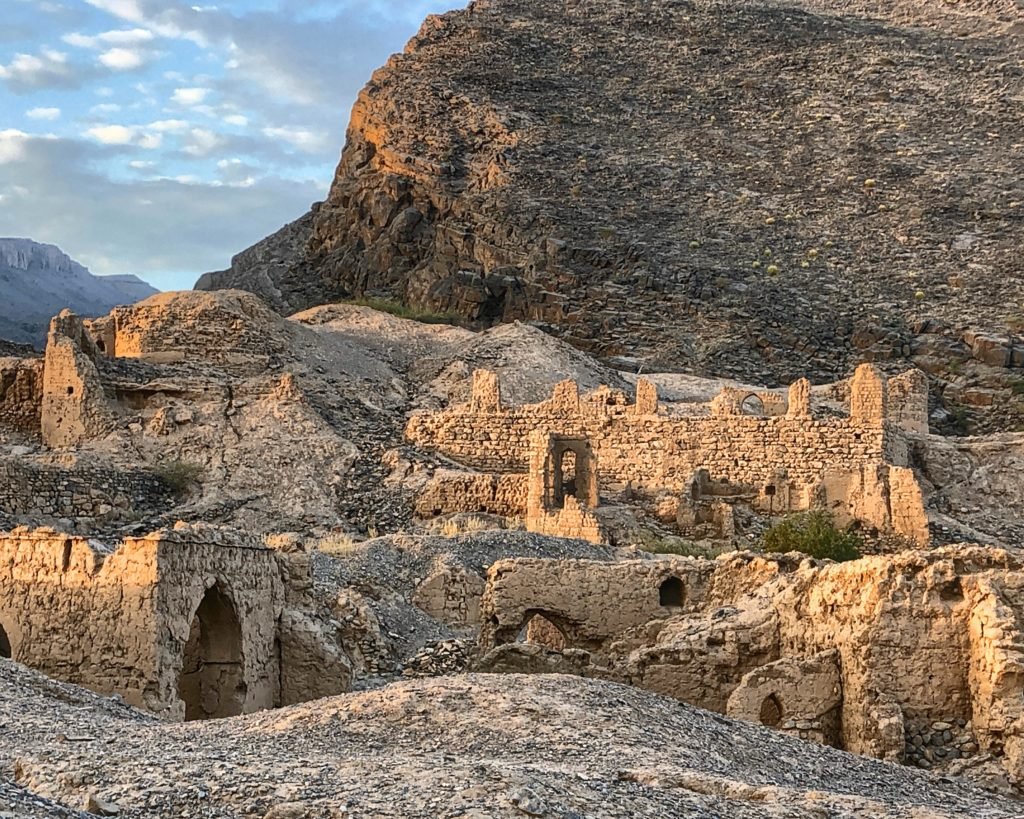

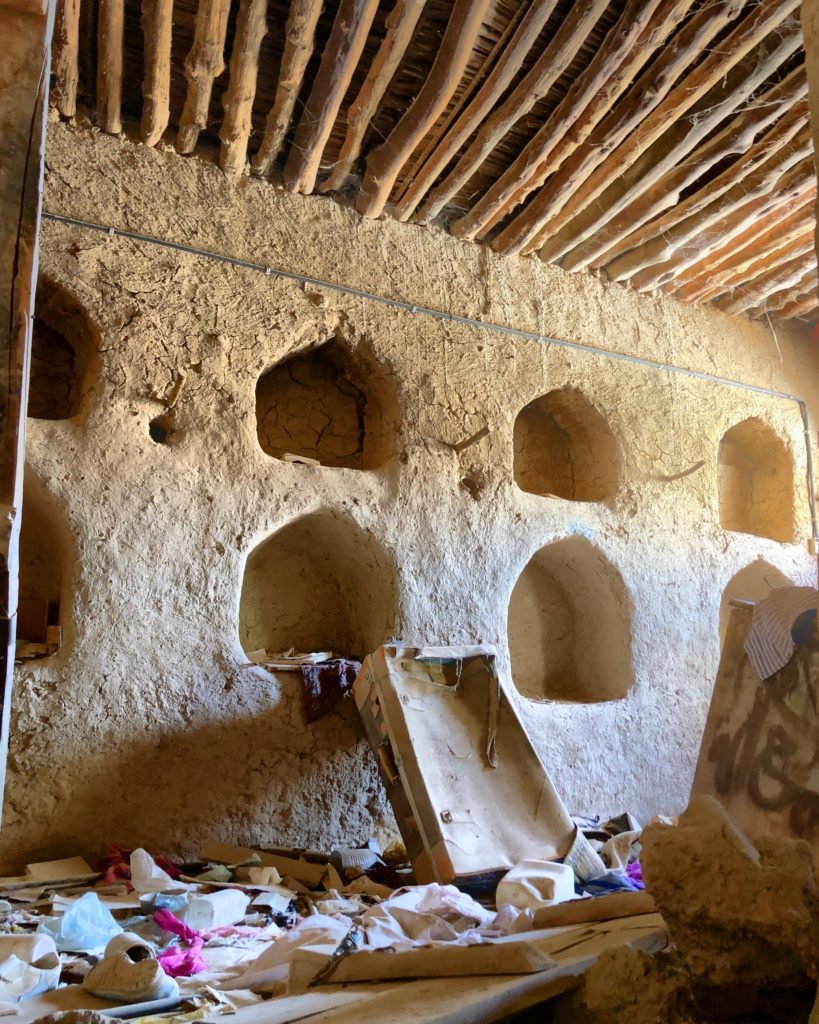
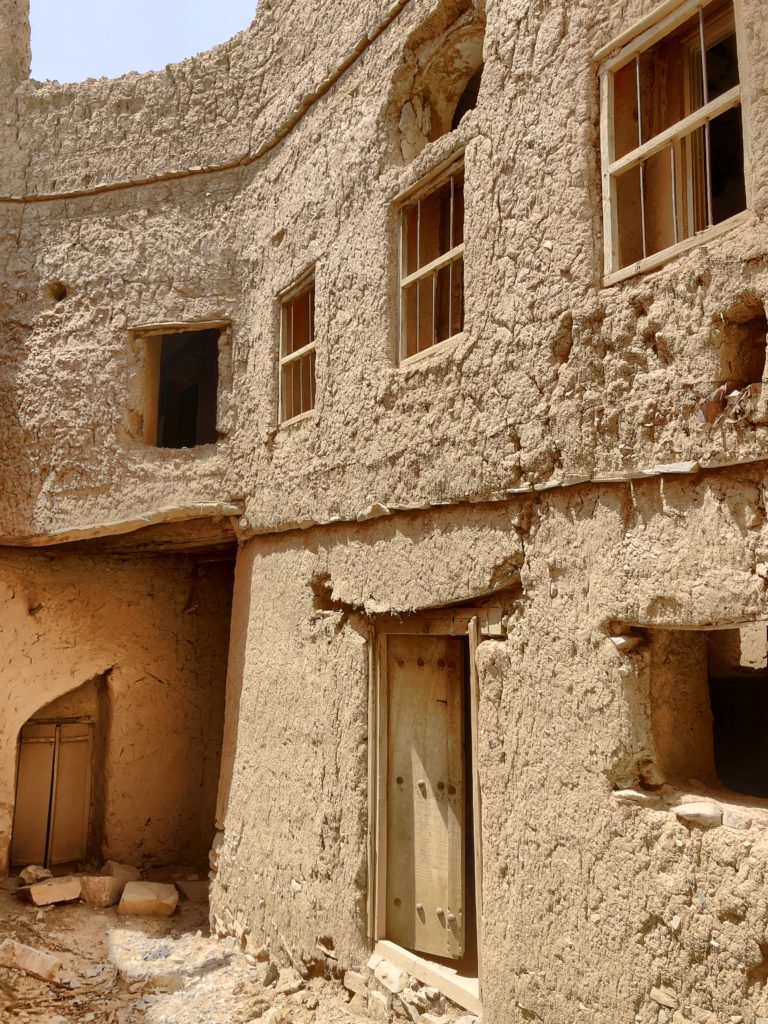



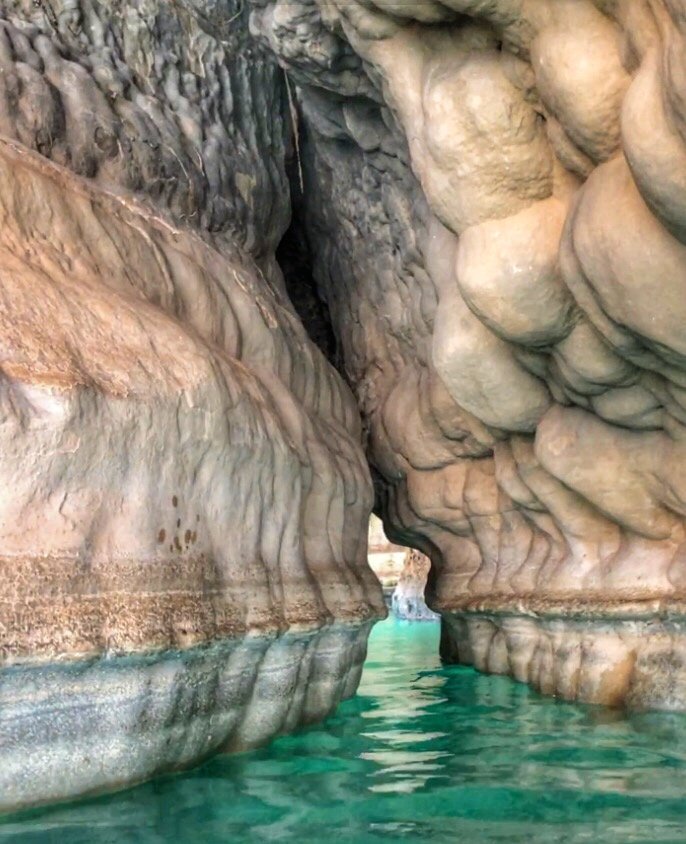
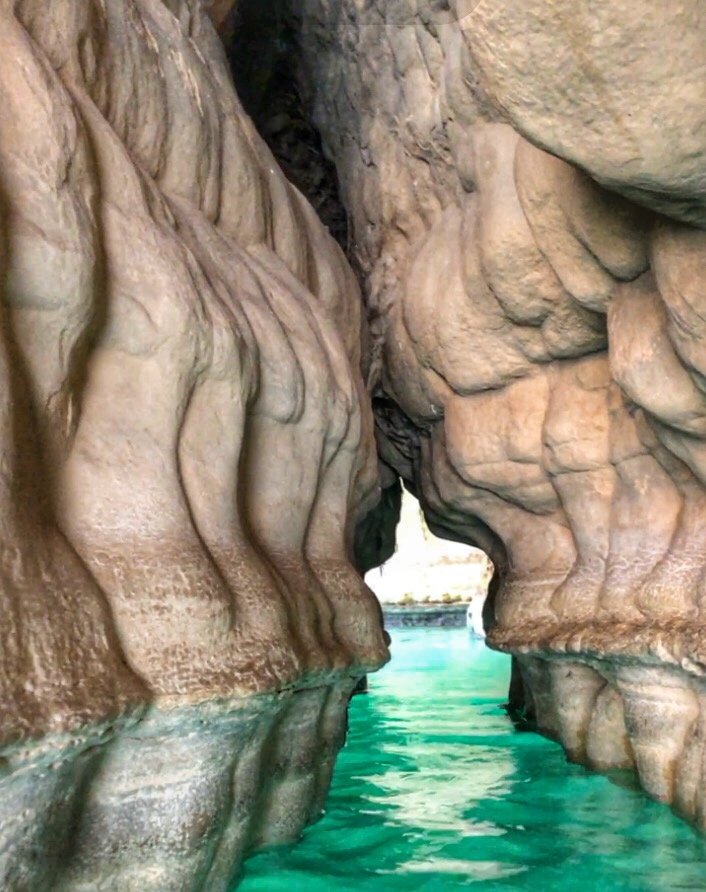






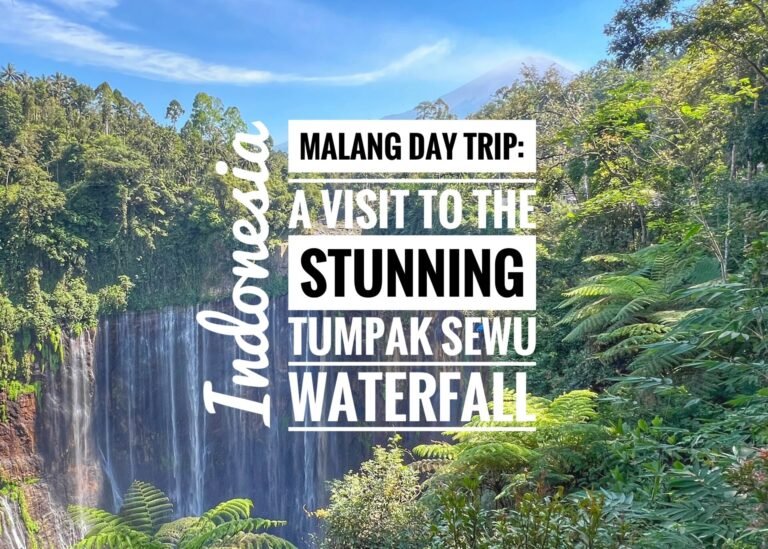


I really enjoy reading these, Mandy. I used Google Maps to find a couple of places for this visit… 🙂
My mom does the same thing 🙂 I’m really glad you’re following along, Amy!
Fabulous post! I love the sense of humor I can see poking out…hauling ass back to the hotel etc :). And hell no on camping with snakes.
Thanks so much for reading and commenting, Megan. 😉 Can’t wait to see you soon!